NicerRides: The Geography of EBikeshare in Minneapolis
Background
Electric Bikes (EBikes) have exploded in numbers over the past few
years, especially in bikeshare
programs.
EBikes have high upfront costs but are easy to adopt, making them an
ideal candidate for bikeshare, which spreads upfront costs over a large
set of users. The Minneapolis bikeshare program NiceRide, currently
operated by Lyft, began offering EBikes over the course of 2020. As an
EBike true believer who commuted through a Minnesota winter,
 I’m pretty excited by what this means for cities. Bikeable cities are a
joy to navigate - you get human-scale amenity density, but with a larger
mobility radius than just by foot. And in my experience EBikes solve a
lot of the adoption problems bikes face by just making biking easy. If
you haven’t tried an EBike, I can’t recommend it enough: it’s just so
damn
pleasant!
I’m pretty excited by what this means for cities. Bikeable cities are a
joy to navigate - you get human-scale amenity density, but with a larger
mobility radius than just by foot. And in my experience EBikes solve a
lot of the adoption problems bikes face by just making biking easy. If
you haven’t tried an EBike, I can’t recommend it enough: it’s just so
damn
pleasant!
Conveniently, NiceRide offers thorough data on trips by their rideshare bikes. This offers a fairly detailed window into what EBikes meant to the bikeshare system. At a high level, EBike option was quite high: the EBike share of rides went from zero to being the clear majority over the course of 2020:
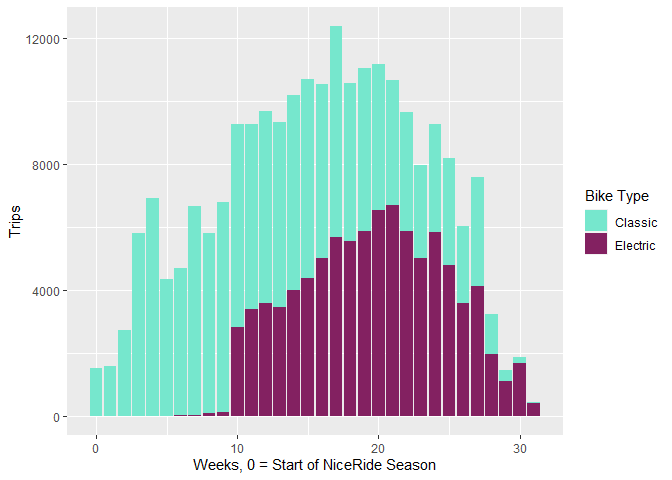
Other research has discussed the impact of EBikes on overall ridership in bikeshare systems. But because the NiceRide data is at the trip level and has detailed location data, it gives us a chance to look specifically at the geography of bikeshare in the Twin Cities!
Bikeshare Geography
As an initial example, here’s a map of where bikeshare rides started in 2020 A quick note: the NiceRide data offers precise coordinates for docked rides, corresponding to the docks where rides started and stopped. But to avoid giving overly identifying details for dockless riders, those ride start/stop locations are rounded to the nearest .01 degrees of longitude and latitude.
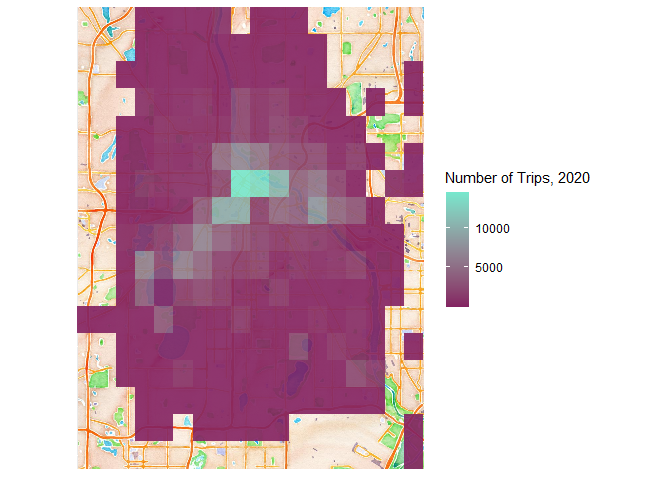
A lot of hopes around EBikes is that they won’t only change the volume of bikers, but will help spread out the geography of where people ride - making more parts of the city bikeable. At a high level, we can see some subtly different patterns looking at the same map for 2019 and 2021, a sort of “before” and “after” EBikes were part of the NiceRide network.
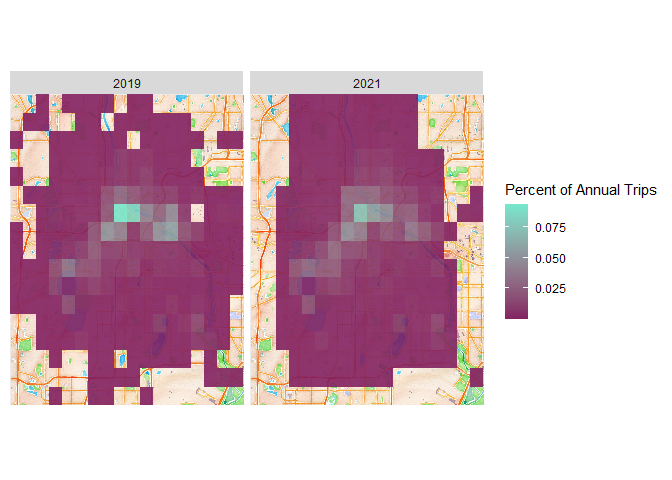
Because EBikes were gradually adopted over the course of 2020, the ride data from that year gives us a chance to more granularly test what EBikes meant for the geography of bikeshare rides in the Twin Cities. In particular, I’m going to look at the data through two lenses. First, I’ll model weekly ride counts between coordinate pairs using Poisson regression to get a handle on the overall dynamics of ride volume. Second, I’ll focus narrowly on the weeks surrounding the big introduction of EBikes to exploit that discontinuity as a natural experiment.
Modeling Ride Counts
The NiceRide data is offered at the ride level, so we have details on every single trip taken that lasts over a minute. Using the rounded coordinates available for each ride to “group” similar start/finish spots together, we can count the number of trips between any two coordinate pairs for any week. For example, here’s a map of where trips starting in two blocks, the first containing the Stone Arch Bridge and the second containing much of the East Bank of the University of Minnesota campus, went in 2020:
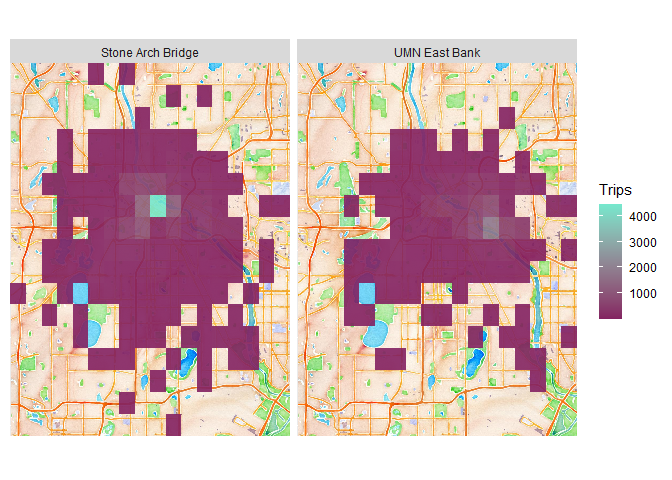
We can look at each of these “start-end” pairs as a single trip category, in order to ask the question “where do people bike in Minneapolis?” Filtering out pairs without rides for the moment, the counts of these pairs has a strongly right-skewed distribution (values at 50 include top-capped records):
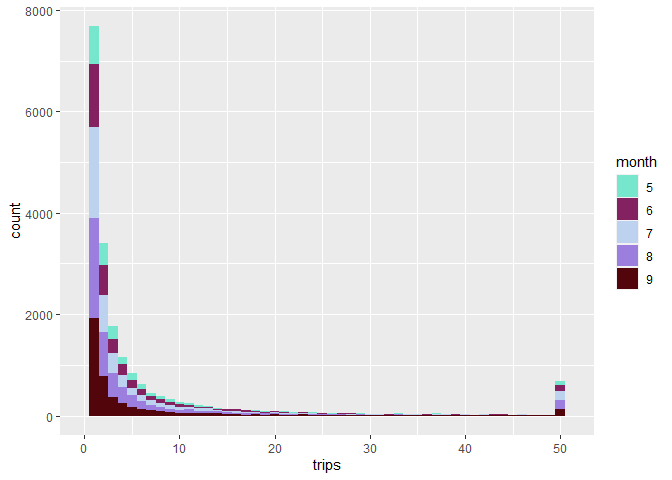
We can model these trip counts using Negative Binomial regression, a subset of Poisson regression. Poisson regression assumes that each value of the response variable is generated from a process following a Poisson distribution, which assumes events happening at a constant rate. Essentially, Poisson regression tries to maximize the likelihood of modeled rates, where likelihood is based on the probability we’d observe the count values provided in Poisson distributions with the predicted rates. More precisely, it estimates the expected log of this rate. Negative Binomial regression generalizes this by letting the variance of the rate not be equal to the rate itself.
The dataset I evaluate below includes a variety of variables. The first category are demographic: using 2010 Census blocks, I include total population in a block, along with descriptive proportions: the percent aged under 18, 18-39, 40-64, and 65+; the percent white, percent black, percent asian, and percent hispanic; the number of households, the percent of households that are owner occupied and the percent that are renter occupied. The second category is economic: I include the count of employees in a block from Census Workplace Area Characterstics data, along with the percent of those employees in retail. The third category is climatic: I include the mean maximum temperate and total precipation for the week in question. The fourth category is geographic: I include the distance between the two blocks, and a dummy variable for whether the block borders Minnehaha Falls (models without this dummy substantially underestimated rides near the falls!). The fifth category is bike-related: I include the number of bikeshare docking stations in the block in 2019, the average trip time between the two blocks in 2019, the volume of rides in the matching week in 2019 (a control on ‘bike season’) and the percent of rides that were on electric bikes in the week in question. The dataset is restricted to blocks with > 25 trip pairs in 2019 and does not include round trips, but does include weeks with zero trips between a pair in 2020. It is evaluated at the weekly level throughout 2020.
## trips week start_pop start_pct_white
## Min. : 0.000 Min. : 0.00 Min. : 2 Min. :0.07748
## 1st Qu.: 0.000 1st Qu.: 7.75 1st Qu.:1788 1st Qu.:0.53619
## Median : 1.000 Median :15.50 Median :2725 Median :0.69087
## Mean : 4.038 Mean :15.50 Mean :3083 Mean :0.64051
## 3rd Qu.: 4.000 3rd Qu.:23.25 3rd Qu.:4310 3rd Qu.:0.84417
## Max. :970.000 Max. :31.00 Max. :7619 Max. :0.94372
## start_pct_black start_pct_hispanic start_pct_asian start_pct_under_18
## Min. :0.00000 Min. :0.00000 Min. :0.00000 Min. :0.00000
## 1st Qu.:0.03516 1st Qu.:0.03252 1st Qu.:0.02955 1st Qu.:0.05689
## Median :0.11944 Median :0.04250 Median :0.04418 Median :0.09420
## Mean :0.16617 Mean :0.07940 Mean :0.06395 Mean :0.12879
## 3rd Qu.:0.25301 3rd Qu.:0.07708 3rd Qu.:0.09326 3rd Qu.:0.19247
## Max. :0.65328 Max. :0.51242 Max. :0.31034 Max. :0.40200
## start_pct_18_39 start_pct_40_64 start_pct_over_65 start_hh
## Min. :0.09957 Min. :0.0000 Min. :0.00000 Min. : 1
## 1st Qu.:0.43759 1st Qu.:0.2212 1st Qu.:0.04415 1st Qu.: 745
## Median :0.50915 Median :0.2611 Median :0.06388 Median :1175
## Mean :0.53948 Mean :0.2562 Mean :0.07552 Mean :1482
## 3rd Qu.:0.63186 3rd Qu.:0.3044 3rd Qu.:0.10764 3rd Qu.:1826
## Max. :1.00000 Max. :0.5397 Max. :0.35901 Max. :5625
## start_pct_renter start_pct_homeowner start_employees start_pct_retail
## Min. :0.03571 Min. :0.0000 Min. : 36 Min. :0.00000
## 1st Qu.:0.56863 1st Qu.:0.1721 1st Qu.: 8362 1st Qu.:0.08386
## Median :0.71936 Median :0.2806 Median : 15145 Median :0.13019
## Mean :0.67045 Mean :0.3296 Mean : 58352 Mean :0.17868
## 3rd Qu.:0.82791 3rd Qu.:0.4314 3rd Qu.: 52857 3rd Qu.:0.26760
## Max. :1.00000 Max. :0.9643 Max. :679710 Max. :0.75138
## mean_max_temp precip distance start_minnehaha
## Min. :33.43 Min. :0.0000 Min. :0.00000 Min. :0.00000
## 1st Qu.:64.50 1st Qu.:0.1500 1st Qu.:0.01414 1st Qu.:0.00000
## Median :72.36 Median :0.6800 Median :0.02236 Median :0.00000
## Mean :70.27 Mean :0.7738 Mean :0.02683 Mean :0.02919
## 3rd Qu.:81.32 3rd Qu.:0.9850 3rd Qu.:0.03606 3rd Qu.:0.00000
## Max. :89.00 Max. :3.3100 Max. :0.10440 Max. :1.00000
## average_time_2019 volume_week_2019 start_docks_19 end_docks_19
## Min. : 371.6 Min. : 516 Min. :0.000 Min. :0.000
## 1st Qu.: 1299.1 1st Qu.: 7381 1st Qu.:1.000 1st Qu.:1.000
## Median : 1938.2 Median :11875 Median :2.000 Median :2.000
## Mean : 4278.1 Mean :11210 Mean :3.061 Mean :2.961
## 3rd Qu.: 3645.4 3rd Qu.:15164 3rd Qu.:4.000 3rd Qu.:4.000
## Max. :109171.9 Max. :19876 Max. :9.000 Max. :9.000
## ebikes_available
## Mode :logical
## FALSE:14730
## TRUE :32406
##
##
##
Using this dataset, I estimated a Zero-Inflated Negative Binomial model with a subset the above variables. A few features turned up during this modeling process: notably, the Minnehaha proximity mattered most when used in conjunction with distance and log population was a more useful predictor than raw population. The variables selected for the final model were picked to avoid interpretative issues resulting from multicollinearity; including multiple demographic variables from the same bucket is particularly tricky for this. I’ve tried to select the most salient subset of each. The critical values for evaluation are the interaction terms between ebikes_available and other demographic variables. When these are positive, that indicates that electric bikes correlated with increased ridership between blocks with these demographics; negative indicates the opposite.
##
## Call:
## zeroinfl(formula = trips ~ volume_week_2019 + start_log_pop + end_log_pop +
## pct_electric * (start_pct_black + start_pct_renter + start_pct_retail +
## start_pct_18_39 + end_pct_black + end_pct_renter + end_pct_retail +
## end_pct_18_39 + mean_max_temp + precip + start_docks_19 + end_docks_19 +
## distance) + distance:start_minnehaha + distance:end_minnehaha |
## volume_week_2019 + distance + start_log_pop + end_log_pop, data = reg_in,
## dist = "negbin")
##
## Pearson residuals:
## Min 1Q Median 3Q Max
## -1.0381 -0.6727 -0.3862 0.3175 28.4468
##
## Count model coefficients (negbin with log link):
## Estimate Std. Error z value Pr(>|z|)
## (Intercept) -3.545e+00 1.195e-01 -29.671 < 2e-16 ***
## volume_week_2019 7.189e-06 NaN NaN NaN
## start_log_pop 1.045e-01 7.485e-03 13.964 < 2e-16 ***
## end_log_pop 1.309e-01 7.753e-03 16.879 < 2e-16 ***
## pct_electric -1.079e+00 2.063e-01 -5.230 1.69e-07 ***
## start_pct_black -1.783e+00 1.232e-01 -14.472 < 2e-16 ***
## start_pct_renter -2.355e-01 9.478e-02 -2.485 0.012964 *
## start_pct_retail 4.174e-01 8.793e-02 4.747 2.07e-06 ***
## start_pct_18_39 -3.923e-02 1.133e-01 -0.346 0.729181
## end_pct_black -1.685e+00 1.238e-01 -13.607 < 2e-16 ***
## end_pct_renter -3.398e-01 9.457e-02 -3.593 0.000327 ***
## end_pct_retail 3.180e-01 8.642e-02 3.680 0.000233 ***
## end_pct_18_39 2.304e-01 1.138e-01 2.024 0.042966 *
## mean_max_temp 3.545e-02 1.015e-03 34.926 < 2e-16 ***
## precip -2.613e-02 1.360e-02 -1.922 0.054657 .
## start_docks_19 2.163e-01 5.514e-03 39.224 < 2e-16 ***
## end_docks_19 2.143e-01 5.582e-03 38.390 < 2e-16 ***
## distance -4.908e+01 8.864e-01 -55.370 < 2e-16 ***
## pct_electric:start_pct_black 1.361e+00 2.620e-01 5.195 2.05e-07 ***
## pct_electric:start_pct_renter 2.957e-01 2.027e-01 1.459 0.144649
## pct_electric:start_pct_retail 3.729e-01 1.865e-01 1.999 0.045609 *
## pct_electric:start_pct_18_39 1.442e+00 2.446e-01 5.896 3.72e-09 ***
## pct_electric:end_pct_black 1.160e+00 2.646e-01 4.383 1.17e-05 ***
## pct_electric:end_pct_renter 4.741e-01 2.028e-01 2.338 0.019374 *
## pct_electric:end_pct_retail 5.337e-01 1.841e-01 2.898 0.003752 **
## pct_electric:end_pct_18_39 1.195e+00 2.459e-01 4.862 1.16e-06 ***
## pct_electric:mean_max_temp -2.658e-03 2.024e-03 -1.313 0.189128
## pct_electric:precip -2.035e-02 3.597e-02 -0.566 0.571581
## pct_electric:start_docks_19 -3.518e-02 1.183e-02 -2.974 0.002935 **
## pct_electric:end_docks_19 -3.647e-02 1.198e-02 -3.045 0.002325 **
## pct_electric:distance -2.149e+00 1.930e+00 -1.113 0.265657
## distance:start_minnehaha 5.994e+00 1.197e+00 5.008 5.50e-07 ***
## distance:end_minnehaha 3.346e+00 1.084e+00 3.085 0.002035 **
## Log(theta) 1.517e-01 6.731e-03 22.535 < 2e-16 ***
##
## Zero-inflation model coefficients (binomial with logit link):
## Estimate Std. Error z value Pr(>|z|)
## (Intercept) 3.018e+00 7.527e-01 4.010 6.07e-05 ***
## volume_week_2019 -2.041e-03 6.654e-05 -30.674 < 2e-16 ***
## distance 5.601e+01 5.369e+00 10.432 < 2e-16 ***
## start_log_pop -1.823e-01 6.770e-02 -2.692 0.0071 **
## end_log_pop -1.175e-01 6.615e-02 -1.775 0.0758 .
## ---
## Signif. codes: 0 '***' 0.001 '**' 0.01 '*' 0.05 '.' 0.1 ' ' 1
##
## Theta = 1.1638
## Number of iterations in BFGS optimization: 71
## Log-likelihood: -7.796e+04 on 39 Df
Is this a good model? I have a few reasons to think so. A Chi-Squared test on residual deviance clearly rejects the null hypothesis; after adding in the zero-inflation step, the model has a dispersion parameter of 1.17, indicating it is not critically overdispersed; the model is preferred to alternate specifications by both AIC and Vuong’s criteria. I’m certain it doesn’t capture all there is to see here, but a predicted-actual plot doesn’t suggest an obvious bias.
The results give us some useful information about how EBike availability impacted where bikeshare rides happened in Minneapolis! In particular, four significant relationships stand out as correlates with the availability of EBikes. First, increased ridership in blocks with higher Black shares of the population; second, increased ridership in blocks with residents aged 18-39; third, decreased (or less increased) ridership in blocks which previously had rideshare docks; and finally, less increased ridership on hotter days. The final one, along with the low-salience relationship between EBike availability and trip distance, stand out as surprises: my expectation was that EBikes would be more pleasant in hotter weather and for longer trips. That may still be true, but this model doesn’t support that conclusion! It does suggest that EBikes, likely by virtue of being dockless, expand the range of bikeshare beyond areas where bike docks were located; and further, that they may increase ridership in areas with young or Black riders. The first of these may speak to younger riders being quicker to adopt new technology - an alternate model suggested EBike availability had a smaller than typical impact with older riders, although that term is not in this model due to multicollinearity with the age 18-39 variable. The second suggests the potential for EBikes to help make bikeshare programs more inclusive within the city - note the prior negative correlation between blocks with high Black population and rides.
I’m still working to build this out and make it more rigorous, so I’ll hopefully have more to say in the future - but I wanted to publish what I have in the meantime!
